Sometimes I need a break from what I'm doing and find myself watching videos on YouTube. Two common themes that keep popping up in my video viewage are animal brilliance and human stupidity. When considering these two themes together, one might realize that these animal behaviors aren't in fact extraordinarily intelligent, but that animals are actually smarter than some humans in some cases and vise versa. Perhaps we don't give them the credit they deserve, and humans set the bar too low for animals and too high for themselves.
This elephant displays patience and foresight and can paint WAY better than I ever could.
A guy on his knees barking while wearing a bark collar.
A dog pulls off a Houdini-style escape from its cage while his friends watch.
A woman sees a rainbow in her sprinkler and - well - says dumb things about it.
A dolphin creates and plays with bubble rings.
A guy pees on an electric fence to see what happens.
Ruby the talking parrot.
Japanese Gameshow - slapped in the balls.
Christin the lion.
Korean baseball fight.
A chimapanze learn to ride a segway.
A list as such wouldn't be complete without the beloved President George W. Bush.
Monday, October 27, 2008
Saturday, October 25, 2008
The Pica Beats at The Vera Project in Seattle on Oct. 24th, 2008
The Pica ("pie-ca") Beats played an all-ages show at The Vera Project last night in Seattle. I'm not a music critic so I have nothing fancy or inspiring to say about them, but I will say I loved the music. The show started out with lead man Ryan Barrett jamming on the sitar, abandoning it after the first two songs for his guitar. Ryan's sitar playing adds delightful spine-tingling ear candy to the band's groove. Alice Sandahl, the newest member of the band, blessed the crowd with her lovely female vocals and mad tambourine skills. I picked up their CD "Beating Back the Claws of the Cold" for $10 and listened to it about 5 times in a row already. If you have a chance, go check them out. Their MySpace page has a sampling of some of their songs. Below are some pictures I took at the show, but unfortunately I didn't get any pictures of the sitar in action. You can find a gallery of the event here.








Tuesday, October 21, 2008
500GB MacBook Harddrive Upgrade for Under $100
 Because of the following two warnings, I created a new article containing easier upgrade instructions and addressing the issue of the 250GB limitation in some MacBooks: MacBook Hard Drive Upgrade Instructions
Because of the following two warnings, I created a new article containing easier upgrade instructions and addressing the issue of the 250GB limitation in some MacBooks: MacBook Hard Drive Upgrade InstructionsWarning #2! (Also see warning #1 directly below.) On July 30, 2009, cjewelz left a comment below saying that he called Apple AS centre about the maximum size they would recommend upgrading to and they said 320 GB. According to cjewelz they said upgrading to 500GB would cause overheating. My MacBook has not had any overheating issues with a 500GB HD. However, I contacted Apple, and what they told me is that my MacBook can be upgraded to a maximum of only 250GB because the HD controller on the motherboard can only handle up to a 250 GB hard drive. I guess this means that when my 500GB HD fills up to ~250GB, weird stuff will occur and my HD will possibly be corrupted and un-useable. I remember calling Apple around the time that I did the upgrade asking about upgrade options and they told me that they could only upgrade to 250GB, but if I brought in a 500GB HD, they would install it for me (for some cost). Hmmm... Mixed messages... So it seems like a 250GB or less upgrade is OK, a 320GB may be not OK, and 500GB is bad. I haven't yet found any website which lists MacBook hard drive size limits according to the different MacBook models. If I get a more concrete understanding of the HD size limitations, I'll post the information so others have it and link to it from here. Proceed with caution.
Warning#1 As of February 25th, 2009, two readers have left comments regarding the Western Digital 500GB Passport Essential external harddrive featured in this article. Apparently the design of the HD has been changed, and you can no longer disconnect the SATA to USB connector from the main harddrive because it is manufactured as one piece. One reader reports a one-piece HD bought in the UK and dated January 2009. If you end up with one of the one-piece HDs, you won't be able to successfully complete the upgrade as described in this article.
However, most of this article is still relevant as reader Zack pointed out. Here is his comment: "Even though the Passports are not compatible anymore this upgrade is still easy and very affordable. I opted to get a drive and enclosure separately rather than the passport and spent $107.68. The quality of the enclosure may not be as good as the Passport enclosure but it's still really small and nice enough. I still recommend and encourage this upgrade and just told someone else about it today."
Following is a hard drive and an enclosure that would work for the upgrade. What's important is the HD needs to have a 2.5 inch form factor and a SATA 2 interface. The enclosure must be the USB/SATA type.
 Link: Western Digital Scorpio
Link: Western Digital Scorpio Link: StarTech InfoSafe
Link: StarTech InfoSafeStart of original article:
The 80GB harddrive that came with my white MacBook I bought a over a year ago (October, 2007) has become the limiting factor of my computing productivity. For example, if I want to tap into my entire mp3 collection through iTunes and have all my pictures in iPhoto while I use the computer, I'm well over 80 GB and am forced to use an external harddrive. With only two USB ports on a MacBook and one of them taken up by an external harddrive, I'm constantly swapping peripheral device USB cables in the remaining port. I love everything else about my MacBook and wouldn't want to upgrade my entire computer yet, and a 500GB harddrive would extend my use of it for at least two more years. Faced with this challenge, I set out to do the upgrade myself and avoid the offensive fees Apple would charge for the upgrade to a maximal measly 250GB.
In a nutshell, to upgrade to a 500GB harddrive on your MacBook while keeping all your existing files, software, settings, and preferences intact for less than $100, follow these simple steps:
- Buy a 500GB external harddrive for ~$150 or less.
- Partition the external drive as a GUID Partition Table drive
- Use SuperDuper! to clone your current bootable harddrive image to the external drive
- Disassemble the external hardrive enclosure
- Swap the external harddrive with the internal harddrive
- Turn on your MacBook and enjoy your extra space
- Repackage the old harddrive into the external harddrive enclosure
- Sell your 80GB external harddrive on Craigslist or eBay for ~$50
Warning: Before you attempt this, backup all your data! Perform this upgrade at your own risk. This worked for me, but I can't guarantee it will work for you! Consider any warranty issues this might cause and call Apple first to see if this will void your warranty and/or AppleCare Protection Plan. Take Electrostatic Discharge (ESD) precautions when handling the harddrive out of it's case or handling any raw circuitry with with your hands. It's never a good idea to directly touch electrical components on a Printed Circuit Board (PCB), but having said that, if you are properly grounded no damage will occur. All you need to do is touch something connected to the ground with your finger to neutralize any static charge your body may be holding before you touch the electronics. If you're not sure of what you're doing, proceed with caution (but do proceed so you learn something new)! I performed this upgrade on my all-white MacBook I bought in October 2007, which is running Mac OSX 10.5.5.
Step 1 - Buy a ~$150 2.5 inch form-factor 500GB external harddrive. The key is to buy one that has a SATA interface, which the vast majority do these days. You can find a good deal on a 500GB harddrive online from a reputable dealer such as Amazon.com. I ended up getting a Western Digital My Passport Essential because the price was right and I figured I could disassemble the enclosure pretty easily. With enough patience and searching, you can find this harddrive for under $150 on websites with special promotions. Update: as of Jan. 26, 2009, 500GB Western Digital My Passport Essential HDs cost only ~$115 on Amazon.com.
 Link: Western Digital My Passport
Link: Western Digital My PassportStep 2 - Partition the external drive as a GUID Partition Table drive. Eric left a comment down below that pointed out you need to have the drive partitioned this way if you ever want to upgrade the OS in the future for an Intel-based Mac. Thanks, Eric! Plug in your new external harddrive to a free USB port. Open Disk Utility and select the external harddrive in the left column. Select the "Partition" tab. Select "1 Partition" as the Volume Scheme. You can give the volume a name now if you like, but you can always change it later. Choose "Mac OS Extended (Journaled)" as the Format. Click on the "Options..." button and choose the "GUID Partition Table". Click "OK" and then "Apply".


Step 3 - Use SuperDuper! to clone your current bootable harddrive image to the external drive. This free software will quickly and easily make an exact copy of your current OS image including all your software, existing files, settings, and preferences - it only takes a few clicks.
 With the external harddrive plugged in the USB port, run SuperDuper! Select: Copy "Macintosh HD" to "500GBHD" (or whatever it's named in your case) using "Backup - all files" and click the "Copy Now" button. After an hour or so depending on how much data you have, the external harddrive will be an exact copy of the harddrive inside your MacBook. While you're waiting, you could check out How to Build a 24-Core Linux Cluster in a $29.99 IKEA Cabinet or How to Identify Bacteria on Your Hands Using DNA Sequencing. Once the cloning is complete you can do a test and boot from the newly created bootable image on the external harddrive by restarting your MacBook and holding the option key. This will let you choose which disk you'd like to boot from. You should be able to boot from the external harddrive at this point and it will look like you booted from the internal harddrive that you just cloned.
With the external harddrive plugged in the USB port, run SuperDuper! Select: Copy "Macintosh HD" to "500GBHD" (or whatever it's named in your case) using "Backup - all files" and click the "Copy Now" button. After an hour or so depending on how much data you have, the external harddrive will be an exact copy of the harddrive inside your MacBook. While you're waiting, you could check out How to Build a 24-Core Linux Cluster in a $29.99 IKEA Cabinet or How to Identify Bacteria on Your Hands Using DNA Sequencing. Once the cloning is complete you can do a test and boot from the newly created bootable image on the external harddrive by restarting your MacBook and holding the option key. This will let you choose which disk you'd like to boot from. You should be able to boot from the external harddrive at this point and it will look like you booted from the internal harddrive that you just cloned.Step 4 - Disassemble the external hardrive enclosure. The construction of harddrives will vary, but whether it's held together by screws or just snapped together, you can probably get it apart one way or another. For the Western Digital My Passport Essential, you need to insert your fingernail or a knife between the top an bottom faces and the long side and pop the pieces apart a bit.
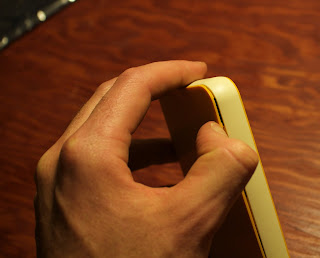

You need to loosen all the snaps all along the long edge, BUT NOT on the shorter edges. After the long edge is loose, gently slide the inner part out of the enclosure. I found it a bit difficult to get the sliding started so I helped it along with by twisting the tip of a flat head screw driver between the inner part and the edge of the cover. As with most things in life, having patience and not forcing things is the key to achieving your goal.
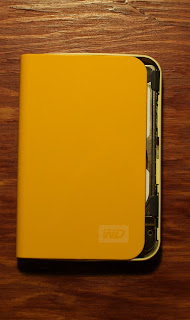
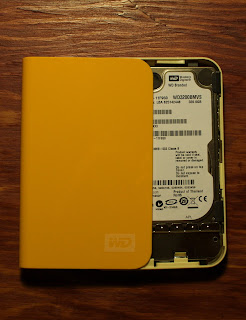
Next, carefully remove the plastic piece encircling the harddrive noting how all the pieces fit together so you'll be able to reconstruct everything with the old harddrive later. Slide the harddrive out of the metal sheath and very very carefully detach the USB connector from the SATA power and data terminals on the harddrive. You might want to use a thin blade and pry apart the connection right where they mate rather than torqueing on the USB PCB with your fingers.
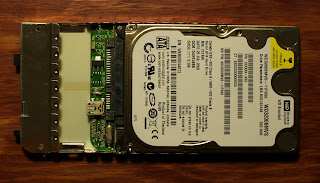
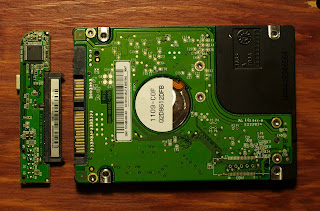
Step 5 - Swap the external harddrive with the internal harddrive. Apple made it very easy to replace harddrives on the MacBook. By the way, for this step, unplug the power from your laptop and shut the computer down. For a complete guide how to do this, you can download Apple's Hard Drive Replacement Instructions. First, remove the battery on the bottom of the laptop using a coin to unlock it. With the laptop flipped upside down and the battery removed, unscrew three little screws using a small Phillips head screw driver that hold a retaining clip. You don't have to fully remove the screws from the retaining clip to remove it. Once the retaining clip is removed, fish out the white plastic flap and pull to slide out the old harddrive.
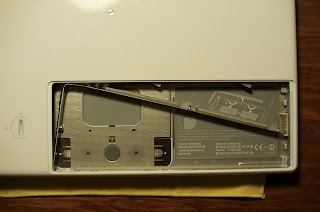
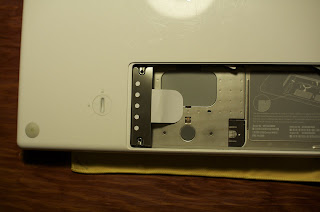
With the old harddrive out, remove the metal sheath from it by taking out the four screws. The screws are kinda funky because they require a star-tipped screwdriver. I just used a pliers to grab onto the screw heads and twist them out. With the old harddrive now completely out, take the new one and in reverse order of taking the old one out, put the new one in.
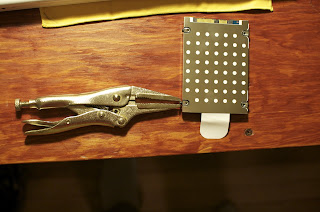 Step 6 - Turn on your MacBook and enjoy your extra space. After you reassembled your MacBook, you should just be able to turn it on like normal and it will boot up from the newly-installed 500GB harddrive. Everything will look and behave just like before except now you'll have tons of extra space! You can right click on the harddrive in Finder and choose "Get Info" and rename the harddrive to something like "MacBook HD" if you like.
Step 6 - Turn on your MacBook and enjoy your extra space. After you reassembled your MacBook, you should just be able to turn it on like normal and it will boot up from the newly-installed 500GB harddrive. Everything will look and behave just like before except now you'll have tons of extra space! You can right click on the harddrive in Finder and choose "Get Info" and rename the harddrive to something like "MacBook HD" if you like.Step 7 - Repackage the old harddrive into the external harddrive enclosure. In reverse of how you disassembled the 500GB harddrive, reassemble the external harddrive package with the old 80GB harddrive being careful to gently put everything in place and slide it all together.
Step 8 - Sell your 80GB external harddrive on Craigslist or eBay for ~$50. Not only will you recoup some of the cost of the 500GB harddrive, but you'll be recycling by selling your perfectly good external harddrive to someone else who needs one. I would recommend using the Disk Utility and securely erase all the data on it though before selling it.
Piece of cake!
Friday, October 17, 2008
7 Humorous Political Images
Props to the creative people who made these. The Obama smiley face is a picture of a sign in our neighbors front window and all the others are from somewhere else in cyberspace.






 The "sign" picture was found here.
The "sign" picture was found here.






 The "sign" picture was found here.
The "sign" picture was found here.Wednesday, October 15, 2008
10 Rad Baseball Cards
It's been years since baseball offered any good entertainment value to me besides some pictures of bats flying into the stands or the Sick Whiffle Ball Pitcher on YouTube. Aren't the Brewers in the World Series or something this year? Whatever.
Anyway, as experienced by most late-twenties males, I was recently faced with the task of trying to figure out what to do with the massive collection of useless baseball cards I spent all my boyhood allowance on to acquire. I seriously had about 60 pounds of cards sorted and grouped in a very large box. My first thought to get rid of them was to put an ad on Craigslist. Maybe all that investing in cards I did back in the day would pay off! Well it seemed like everyone in Seattle was selling their early 90s baseball card collection too and for only $10. I went through the entire collection and picked out the best cards I had - players like Nolan Ryan, Ken Griffey Jr., Sammy Sosa, etc. - and filled up one binder, which was the limit I decided on. I saved a few for my bike spokes, and burnt the rest. If I spent all that cash on them, I was at least going to have a memorable farewell.
Things do change though when you grow up. As I was collecting the cards, all I cared about was getting the "good" cards for bragging rights with my friends. Now, as I sorted through the 60 pound box of cards in order to rid myself of the extra poundage, I was most entertained by the "worthless" cards that featured a chap with a dazzling expression or a humorous name. Willie McGee, Ross Grimsley, Steve Trout, thanks for making baseball entertaining...










Anyway, as experienced by most late-twenties males, I was recently faced with the task of trying to figure out what to do with the massive collection of useless baseball cards I spent all my boyhood allowance on to acquire. I seriously had about 60 pounds of cards sorted and grouped in a very large box. My first thought to get rid of them was to put an ad on Craigslist. Maybe all that investing in cards I did back in the day would pay off! Well it seemed like everyone in Seattle was selling their early 90s baseball card collection too and for only $10. I went through the entire collection and picked out the best cards I had - players like Nolan Ryan, Ken Griffey Jr., Sammy Sosa, etc. - and filled up one binder, which was the limit I decided on. I saved a few for my bike spokes, and burnt the rest. If I spent all that cash on them, I was at least going to have a memorable farewell.
Things do change though when you grow up. As I was collecting the cards, all I cared about was getting the "good" cards for bragging rights with my friends. Now, as I sorted through the 60 pound box of cards in order to rid myself of the extra poundage, I was most entertained by the "worthless" cards that featured a chap with a dazzling expression or a humorous name. Willie McGee, Ross Grimsley, Steve Trout, thanks for making baseball entertaining...










Monday, October 13, 2008
How to Watermark an Image (for Free)
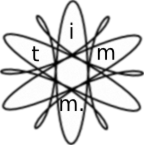 JetPhoto Studio is a great little freeware application for Mac and PC for adding a watermark to your images. I spent a great deal of time trying to find a freeware program for my Mac that would add a watermark to a batch of images I wanted to publish on the web. There was plenty on freeware for a PC and plenty of software for a Mac that came with a price, but the program I desired was very elusive. One option that I wasn't too excited about was using Picasa, but you could only add text rather than an image as a watermark. After many failed Google searches, I ended up on download.com and did a search for "watermark" and filtered the results to only show results with free licences. There were four options and none looked too promising. To make a long and boring story short and exciting - I downloaded JetPhoto Studio and it rocks! The following is an illustrated guide to add a watermark to an image with JetPhoto Studio.
JetPhoto Studio is a great little freeware application for Mac and PC for adding a watermark to your images. I spent a great deal of time trying to find a freeware program for my Mac that would add a watermark to a batch of images I wanted to publish on the web. There was plenty on freeware for a PC and plenty of software for a Mac that came with a price, but the program I desired was very elusive. One option that I wasn't too excited about was using Picasa, but you could only add text rather than an image as a watermark. After many failed Google searches, I ended up on download.com and did a search for "watermark" and filtered the results to only show results with free licences. There were four options and none looked too promising. To make a long and boring story short and exciting - I downloaded JetPhoto Studio and it rocks! The following is an illustrated guide to add a watermark to an image with JetPhoto Studio.Step 1: Open JetPhoto Studio and create a new album, which I called "Watermark Demo".

Step 2: Drag and drop one or more images into the new album.

Step3 : Click on the "Actions" tab, and click on "Web Ready".

Step 4: Click on the "Resize" tab and select what size images you want generated. I only wanted a watermark on my demo image at a size of 1600 X 1200 pixels.

Step 5: Click on the "Watermark" tab and drag and drop your watermark mask into the rectangle. My watermark mask is white so you can't really see it too good. Select where you want the watermark positioned on your image.

Step 6: Click "Export Now!" and a folder will be placed on your desktop with your watermarked image(s).
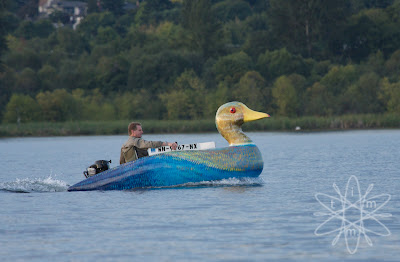
To my delight, I have once again managed to find and use either freeware or open source software to accomplish what I need. I thank all the people (in this the case JetPhoto Studio authors and supporters) who put so much work into making free and quality software. BTW, I used Inkscape, an amazing open source application for creating professional vector graphics (like Adobe Illustrator) for my watermark. I'll probably be doing more illustrated how-to guides on other freeware and open source software for the Mac in the future.
See also: Photos of Greylag Goose with a different style watermark
Submit Photos to Shutterstock and make $$$!
Friday, October 10, 2008
Tamron AF 180mm f/3.5 1:1 Macro Lens
 In macro or "close-up" photography the image of the subject projected onto the film or sensor is roughly the same size as the object itself. For example, an image of a 35-mm long bug would stretch across the entire width of the film of a 35-mm camera. In most opinions, a lens is considered a "standard macro" if a ratio of 1:1 is achieved, but magnifications of 1:2, where the image on the sensor is half the size of the object can also be considered macro. Some lenses can even achieve ratios up to 5:1 and are used for imaging insect eyeballs and other microscale detail. Macro lenses such as the Tamron AF 180mm f/3.5 are optimized for the 1:1 magnification ratio. One afternoon I borrowed this lens from my uncle, who uses it for all his macro work, and went out to shoot some insects. I found that the working distance of the lens, approximately 2 feet, kept me far enough away from the insects so I didn't scare them away. I love the sharpness and quality of the images. Here are some pictures, click on them for full resolution and to see some amazing close up details of insects and spiders...
In macro or "close-up" photography the image of the subject projected onto the film or sensor is roughly the same size as the object itself. For example, an image of a 35-mm long bug would stretch across the entire width of the film of a 35-mm camera. In most opinions, a lens is considered a "standard macro" if a ratio of 1:1 is achieved, but magnifications of 1:2, where the image on the sensor is half the size of the object can also be considered macro. Some lenses can even achieve ratios up to 5:1 and are used for imaging insect eyeballs and other microscale detail. Macro lenses such as the Tamron AF 180mm f/3.5 are optimized for the 1:1 magnification ratio. One afternoon I borrowed this lens from my uncle, who uses it for all his macro work, and went out to shoot some insects. I found that the working distance of the lens, approximately 2 feet, kept me far enough away from the insects so I didn't scare them away. I love the sharpness and quality of the images. Here are some pictures, click on them for full resolution and to see some amazing close up details of insects and spiders...






See also:
Ten German Birds
Submit Photos to Shutterstock and make $$$!